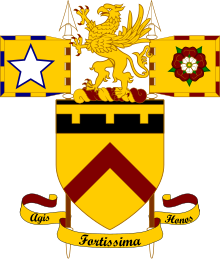
The United States Department of War, also called the War Department, was the United States Cabinet department originally responsible for the operation and maintenance of the United States Army, also bearing responsibility for naval affairs until the establishment of the Navy Department in 1798, and for most land-based air forces until the creation of the Department of the Air Force on September 18, 1947.
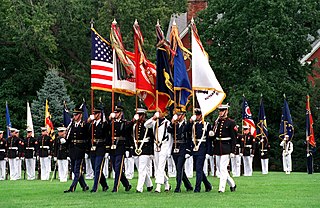
The several branches of the United States Armed Forces are represented by flags. Within the U.S. military, various flags fly on various occasions, and on various ships, bases, camps, and military academies.
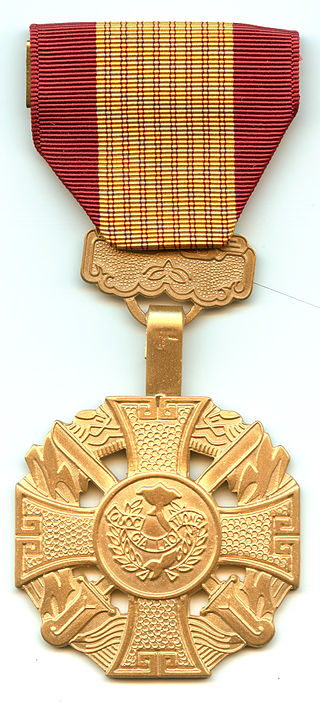
The Republic of Vietnam Gallantry Cross also known as the Vietnamese Gallantry Cross or Vietnam Cross of Gallantry is a military decoration of the former Government of South Vietnam. The medal was created on August 15, 1950, and was awarded to military personnel, civilians, and Armed Forces units and organizations in recognition of deeds of valor or heroic conduct while in combat with the enemy.
The World War II Victory Medal is a service medal of the United States military which was established by an Act of Congress on 6 July 1945 and promulgated by Section V, War Department Bulletin 12, 1945.
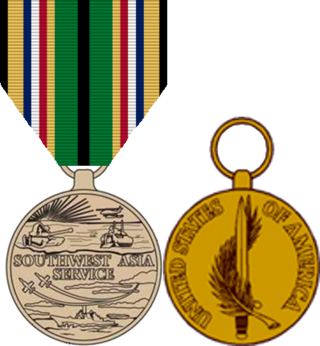
The Southwest Asia Service Medal is a military award of the United States Armed Forces which was created by order of President George H.W. Bush on March 12, 1991. The award is intended to recognize those military service members who performed duty as part of the Persian Gulf War and for a time thereafter. The medal was designed by Nadine Russell of the Army's Institute of Heraldry. The colors of the ribbon are tan, representing sand, with the black, white, red, blue, and green colors symbolizing the colors of coalition countries' national flags.

The 81st Readiness Division ("Wildcat") was a formation of the United States Army originally organized as the 81st Infantry Division during World War I. After World War I, the 81st Division was allotted to the Organized Reserve as a "skeletonized" cadre division. In 1942, the division was reactivated and reorganized as the 81st Infantry Division and served in the Pacific during World War II. After World War II, the 81st Infantry Division was allotted to the Organized Reserve as a Class C cadre division, and stationed at Atlanta, Georgia. The 81st Infantry Division saw no active service during the Cold War and was inactivated in 1965.

The Parachutist Badge, also commonly referred to as "Jump Wings", is a military badge of the United States Armed Forces. Some services, such as the Marine Corps, officially refer to it as an insignia instead of a badge. The United States Space Force and United States Coast Guard are the only branches that do not award the Parachutist Badge, but their members are authorized to receive the Parachutist Badges of other services in accordance with their prescribed requirements. The DoD military services are all awarded the same Military Parachutist Badge. The U.S. Army and U.S. Air Force issue the same Senior and Master Parachutist Badges while the U.S. Navy and U.S. Marine Corps issue the Navy and Marine Corps Parachutist Insignia to advanced parachutists. The majority of the services earn their Military Parachutist Badge through the U.S. Army Airborne School.

Obsolete badges of the United States military are a number of U.S. military insignia which were issued in the 20th and 21st centuries that are no longer used today. After World War II many badges were phased out of the United States Armed Forces in favor of more modern military badges which are used today.

The United States Army Training and Doctrine Command (TRADOC) is a major command of the United States Army headquartered at Fort Eustis, Virginia. It is charged with overseeing training of Army forces and the development of operational doctrine. TRADOC operates 37 schools and centers at 27 different locations. TRADOC schools conduct 1,304 courses and 108 language courses. The 1,304 courses include 516,000 seats for 443,231 soldiers; 36,145 other-service personnel; 8,314 international soldiers; and 28,310 civilians.

The United States Army Quartermaster Corps, formerly the Quartermaster Department, is a sustainment and former combat service support (CSS) branch of the United States Army. It is also one of three U.S. Army logistics branches, the others being the Transportation Corps and the Ordnance Corps.
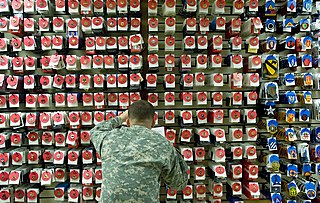
A distinctive unit insignia (DUI) is a metallic heraldic badge or device worn by soldiers in the United States Army. The DUI design is derived from the coat of arms authorized for a unit. DUIs may also be called "distinctive insignia" (DI) or, imprecisely, a "crest" or a "unit crest" by soldiers or collectors. The U.S. Army Institute of Heraldry is responsible for the design, development and authorization of all DUIs.

In the United States Army, soldiers may wear insignia to denote membership in a particular area of military specialism and series of functional areas. Army branch insignia is similar to the line officer and staff corps officer devices of the U.S. Navy as well as to the Navy enlisted rating badges. The Medical, Nurse, Dental, Veterinary, Medical Service, Medical Specialist, Chaplains, and Judge Advocate General's Corps are considered "special branches", while the others are "basic branches".
United States Army commissioned officers rank insignia in use today.

Heraldry in the United States was first established by European settlers who brought with them the heraldic customs of their respective countries of origin. As the use of coats of arms may be seen as a custom of royalty and nobility, it had been debated whether the use of arms is reconcilable with American republican traditions. Families from English, Scottish, Irish, Welsh, German, and other European nations with a heraldic tradition have retained their familial coat of arms in the United States. Several founding fathers also employed personal arms and a great number of Americans continue to do so.
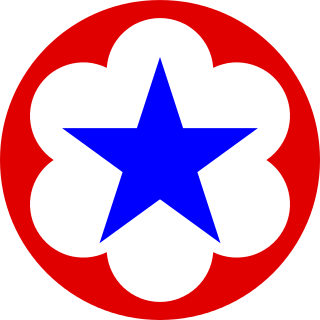
The Army Service Forces was one of the three autonomous components of the United States Army during World War II, the others being the Army Air Forces and Army Ground Forces, created on 9 March 1942. By dividing the Army into three large commands, the Chief of Staff, General George C. Marshall, drastically reduced the number of officers and agencies reporting directly to him. The Army Service Forces brought together elements of five different components of the Army: elements of the War Department General Staff (WDGS), especially its G-4 division ; the Office of the Under Secretary of War; the eight administrative bureaus; the nine corps areas, which became service commands; and the six supply arms and services, which became known as the technical services. The Army Service Forces was initially known as the United States Army Services of Supply but the name was changed on 12 March 1943, as it was felt that the term "supply" did not accurately describe the broad range of its activities. The Army Service Forces was abolished on 11 June 1946 and most of its functions were taken over by the War Department General Staff.
In the United States Armed Forces, a brigadier general is a one-star general officer in the United States Army, Marine Corps, Air Force, and Space Force.
Quartermaster sergeant (QMS) is a class of rank or appointment in some armed forces, especially those of the United Kingdom and the Commonwealth, and formerly also in the United States.
Edward C. Kuhn was an American heraldist and official U.S. Army artist who designed the first authorized coats of arms and distinctive unit insignia for the U.S. Army Coast Artillery Corps, Engineer Corps, Cavalry, Infantry, National Guard and other branches. An expert on flags, heraldry, embroidery, and military antiquities, Kuhn made significant contributions to American military history. A number of Kuhn's paintings are included in the permanent collections of the White House, U.S. Naval Academy Museum and the Smithsonian Institution.

In the United States (US) military, a beret flash is a shield-shaped embroidered cloth that is typically 2.25 in (5.72 cm) tall and 1.875 in (4.76 cm) wide with a semi–circular base that is attached to a stiffener backing of a military beret. These flashes—a British English word for a colorful cloth patch attached to military headgear—are worn over the left eye with the excess cloth of the beret shaped, folded, and pulled over the right ear giving it a distinctive appearance.
The United States Army's enlisted rank insignia that was used during World War I differs from the current system. The color scheme used for the insignia's chevron was olive drab for field use uniforms or one of several colors depending on the corps on dress uniforms. The chevron system used by enlisted men during World War I came into being on July 17, 1902, and was changed to a different system in 1919. Specification 760, which was dated May 31, 1905, contained 45 different enlisted insignia that varied designs and titles by different corps of the Army. General Order Number 169, which was enacted on August 14, 1907, created an even larger variety of enlisted rank insignia. Pay grades similar to the current system were not yet in use by the U.S. Army, and instead, the pay system reflected the job assignment of the soldier rather than their rank. By the end of World War I, the system contained 128 different insignia designs.



